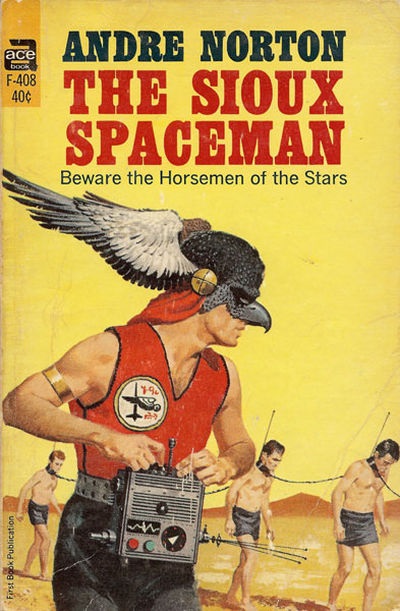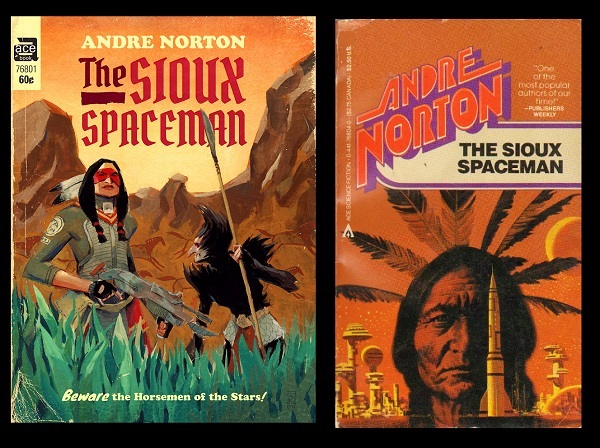"The Sioux Spaceman" by Andre Norton ~ 10.30.17
It’s amazing, if you think of it, how the covers of science-fiction paperbacks are so often completely misleading.
This is true to some extent for paperback novels in general, but it seems to be the case most often in the sci-fi genre.
I have no idea why that is. Or maybe I do.
One reason: That other species
One reason may have to do with the core audience of science fiction — teenage boys and young men as well as older men who, in some part of their being, remain teenage boys or young men. These are readers who tend to be bookish and more than a little shy.
That may explain why, for the most part, there’s little or no sex in the regular run of futuristic novels although this has changed somewhat in recent years. Still, even today, most sci-fi gives its primary focus to the nuts and bolts of technology, ignoring those messy things like emotions and lusts.

You wouldn’t know that, however, if you judged the books by their covers.
This was especially true when pulp science fiction magazines regularly portrayed a hardly clothed creature from that other species…er, that other sex…on their covers.
A slinky star-pointer
It’s continued today. Just look this cover on the right of the 1968 edition of They Shall Have Stars by James Blish, originally published twelve years earlier.
That image of a slinky nude woman pointing off to the cosmos makes the book seem like one kind of novel. But it isn’t.
Nearly all of its characters — and certainly all of its important characters — are men doing a lot of complicated and very earnest skullduggery in government offices, business headquarters and laboratories to find a way to sneak a spaceship into flight.
Not a single nude woman pointing at the stars shows up in the book’s pages.
So why on the cover? Well, the covers titillate all those shy teenage boys and young men (who know that the stories inside aren’t going to unsettle them with untidy feelings and urges).
“Hair to clothe her”
Books by prolific sci-fi author Andre Norton — a woman born Alice Norton who adopted a male name, the better to be accepted by her primarily male audience — get a lot of these sexy covers. But not always. Consider the images below:

Norton was a writer who was much more at home with, say, telepathy between a young man and a large cat or bird than with romantic entanglements.
Nonetheless, “People of the Crater,” a novella that was her first published science fiction, appearing in 1947 in the first issue of Fantasy Book, featured an unclothed woman on the cover — who doesn’t appear anywhere in the novella.
There actually is a nude woman — an ancient human-like alien, to be exact — in Norton’s Exiles of the Stars, and one edition of the book does feature the outline of a naked lady doing a sort of go-go dance although no go-go dance is carried out in the story.
However, the cover of the 1971 hardcover edition (above, right) is a much better reflection of the novel.
That’s because this ancient alien, held for eons in stasis, is nude but not in a sexy way — and she’s covered up anyway, as Norton explains.
But the fourth was a woman! None of those behind the walls were clothed except for their crowns. And their bodies were flawless, skin to the ideal of beauty held by my species. The woman was such perfection as I had never dreamed could exist in the flesh.
The speaker is a human named Krip Vorlund, but it’s not clear how he knows this woman is so perfect since he adds:
From beneath her diadem flowed hair to clothe her almost to her knees.
And that’s pretty much how she stays for the rest of the novel. There’s no ogling, no hanky-panky — not in an Andre Norton book!
The other reason: Complexity
The other reason science fiction novels tend to have misleading covers probably has to do with the complexity of the stories.
The goal of the science fiction writer is to create a future world or an alternative world that may have some parallels with the Earth we know and love but is its own place.
This means that much of what the writer of a literary novel or a romance novel or a crime novel is able to take for granted has to be created by the sci-fi writer.
If, for instance, in a crime novel, Character A goes into the basement of a 12-story high-rise and finds a dead body with a knife in the forehead, she may take out her cell phone and call Character B.
Simple. Readers know what a 12-story high-rise is, and a basement, and a knife, and a cell phone.
But, in a science fiction novel, there is a lot the writer has to figure out and then explain to the reader:
What kind of building it is in this world? What does the lower level look like and what is it used for? What sort of wound will there be in the body, from what sort of weapon? Is the body human or alien? If alien, what does it look like? And, once the discovery occurs, how does Character A communicate with Character B?
Sneaking around as traders
A case in point is Norton’s 1960 novel The Sioux Spaceman. Kade Whitehawk is the titular Native American, and he finds himself on Klor, one of many planets controlled by a nasty but technologically savvy alien race called the Styor.
Kade is one of a group of human agents who have a foothold in the world as traders. The Sklor look down on the humans but like some of the merchandise they offer. A subtext is that the humans are searching for vulnerabilities in the Sklor technology which is too strong for them to attack directly.
The concept of human agents sneaking around alien worlds as traders was a central element in Norton’s Time Traders series — The Time Traders (1958), Galactic Derelict (1959) and The Defiant Agents (1962). The second and third novels in the series feature an Apache character, Travis Fox.
Native Americans
It seems clear that, in those two Time Traders books and in The Sioux Spaceman, Norton thought that Native Americans could be employed in such ventures because their ancestry as nomads only a few generations earlier would enable to them to relate to primitive races on other worlds.
This is an idea that, as Norton presents it, strikes me as racist.
Yet, I know that some Native Americans remain very much in tune with their ancestral customs and traditions, and there might be some way of capitalizing on that — in a non-racist way. In addition, there was a version of this employed in World War I and World War II — the “code talkers” who used Native American languages in transmitting coded messages.
In The Sioux Spaceman, the primitive creatures are the Ikkinni, and, based on the notes of an earlier, murdered Native American agent, Kade realizes that the Ikkinni are a lot like the Sioux back on Earth before the tribe got horses. With horses, they would be able to cause a lot of problems for the Styor. And that would be to the benefit of the humans in the galaxy.
Thrown-up hands
So, Norton’s plot is fairly complex and, in its way, nuanced — and not very easy to convey in a single image on the cover.
Here are two examples of how it’s been approached:

Both of them seem to have been produced by artists who, in the face of the complex story, simply threw up their hands and decided: “The hell with it, I’ll just give them something vaguely space-ish for a cover.”
That seems to explain the image on the right which features people walking away from a spaceship.”
The problem here, aside from the complete vagueness of the image, is that the people are shown with their heads enclosed in clear helmets, something no one of Klor has to wear.
The other is vague in a strange way. There is no indication on the dust jacker for the source of the image, but it appears it may be a Native American carving of some sort. There is a stone carving that is a plot point in the carving, but Norton’s description of it bears no resemblance to the image on this cover.
Nothing like the guy

Here is a cover image that is rooted very slightly in the novel, but it appears to be based on a complete misreading of the text.
The novel has a character named Buk who operates a small portable machine that controls the Ikkinni. All he has to do is press a button, and the metal collar around an Ikkinni’s neck will jolt him into spasms of unbearable pain.
Those men walking in chains are supposed to represent the Ikkinni although, with the machine, Buk doesn’t need to put them in chains. Also, the Ikkinni don’t look that much like humans.
The guy with the machine looks even less like Buk whom Norton describes as:
A corpulent humanoid, his yellowish skin stretched in a greasy band over a wobbling paunch…[with a] hairless head,,,[with] three horn-like bumps across the forehead, and…a sharply pointed chine [that] retreated as thick wattle of loose skin into his big neck.
In other words, he looks nothing like the guy on the cover….
The Sioux as a bad guy?
….who, with that head-dress, could be the Sioux of the title!
That’s the really confusing thing about this cover. It makes it seem that the Sioux spaceman is the guy who’s enslaving these victims.
It makes the good guy seem to be a bad guy!
Well, the constant re-issuing of science fiction titles means that there are often many versions, and the two below show that, at times, a cover can be reasonably accurate.

Neither is perfect, but, for my money, the one on the right is the better of the two — and, for me, at least, the most interesting.
(Webmasters Note: The image on the left is not a real cover image - it is from an art project where Artist were tasked with re-imagining book covers.)


